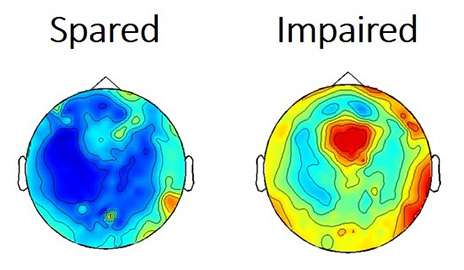Disruptions of brain activity in absence seizures – in which subjects lose consciousness for a brief period (right) – are more global than scientists had believed. Credit: Blumenfeld lab
Scientists believed that absence seizures—the brief loss of consciousness often mistaken for day-dreaming—was caused by a localized disruption of brain activity. A new Yale study finds the entire brain is involved in this common form of childhood epilepsy that causes kids to "blank out" for 10 seconds or more at a time.
"These seizures significantly affect school performance, social interactions and can also pose safety risks," said Dr. Hal Blumenfeld, the Mark Loughridge and Michele Williams Professor of Neurology and senior author of the study appearing Nov. 7 in The Lancet Neurology.
Seizures typically last less than 10 seconds but can also last longer and be accompanied by movements such as blinking, chewing or hand gestures. In severe cases, these seizures can happen hundreds of times a day.
The Yale team collected brain electrical signaling and fMRI data from 39 children undergoing absence seizures and found disruptions were global, not localized. Also, they found that in more severe seizures, disruptions began even before symptoms of seizures began.
"Understanding impaired consciousness in childhood absence epilepsy can also improve understanding of other disorders of consciousness including head trauma, coma and stroke," Blumenfeld said.
More information: Jennifer N Guo et al. Impaired consciousness in patients with absence seizures investigated by functional MRI, EEG, and behavioural measures: a cross-sectional study, The Lancet Neurology (2016). DOI: 10.1016/S1474-4422(16)30295-2
Journal information: Lancet Neurology
Provided by Yale University






















